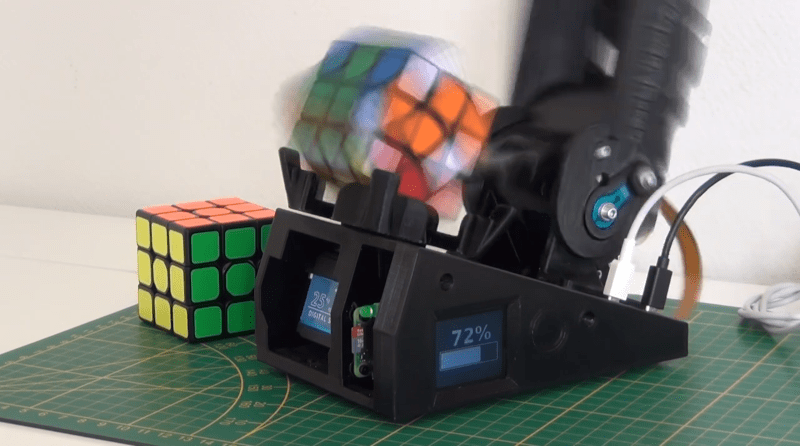[AndreaFavero] says that the CuboTino emphasizes simplicity and cost-savings over speed. However, solving the puzzle in about 90 seconds is still better than we can do. The plucky solver uses a Pi and a camera to understand what the cube looks like and then runs it through a solver to determine how to move.
Watching the video below, we were impressed with the mechanics. The titled surface solves a few problems and makes manipulation easier. The way the mechanics are arranged, it only takes a pair of servos to flip the cube around as you like.
Apparently, out of the 90 seconds it takes to solve the cube, about 30 seconds is just looking at it. This isn’t a quick afternoon 3D print. There are 13 separate parts, although all should be fairly easy to print.
Granted, we’ve seen plenty of cube solvers before. But it is always interesting to see how different people approach the same problem. This machine, by the way, is an evolution of an earlier one we’ve seen from [AndreaFavero] before. If you think the instructions look a little light, note that you have to download the full instructions as a PDF file. That’s where all the details are.
If you want to build something more complex, you can go faster. As you’ll see, though, it is a lot more work to get that extra speed.















This looks almost exactly like the “Mindcuber” (google it) I built years ago.
There are many different examples of ’tilted’ robots solving the Rubik’s cube; I think the first one is from Hans Andersson back on 2008 (https://www.youtube.com/watch?v=5fAn5A0HbhU&t=2s).
On the other hand, I don’t think there are other designs with only two pivots …. at least not that I’m aware of.
I like it!
Future versions could simplify the hardware build (and lower costs) by offloading features to the user’s smartphone: Make the Pi Zero be a wifi hotspot that hosts a web app which guides the user to first camera scan the sides of the scrambled cube and, second, place the cube in the solver with one specific corner tile in a specific location. After that the machine performs the solution steps – no more visual input needed. BOM can then remove screen, Pi Camera and start button.
CUBOTino is meant to be scalable in costs and complexity; I started from the base version with the target to be as cheap as possible: https://youtu.be/ZVbVmCKwYnQ
The phone idea is a very good proposal, the onlt downside is I’ve first to learn coding for phones ….
Great individual home project. MIT holds thee record I think with their robot solving in 0.38 seconds:
https://bigthink.com/the-future/rubiks-cube/